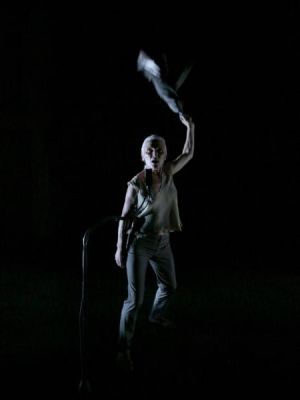riverrun
Olwen Fouere, a slight figure in grey, stands on an stage empty but for a cable that snakes like the river Liffey itself to a lone microphone. White powder differentiates the river from the bank. Taking off her shoes, Fouere wades into it, and, reaching the centre of the stage and the microphone, she calls, hauntingly, the Sanskrit words that herald the twilight of dawn: Sandhyas! Sandhyas! Sandhyas!
Thus begins an incredibly poetic interpretation of “the dark matter somewhere between energy and form, music and language …” that is James Joyce’s Finnegan’s Wake. Described as both a non-linear digressive narrative and an aporia – an impasse or a philosophical puzzle – the book is filled with twisted literary allusions, puns and composite words from over sixty languages.
While Joyce explained this – “The action of my new work takes place chiefly at night. It’s natural things should not be so clear” – Fouere has taken selective passages and gathered them into a performance that, whilst still a ‘puzzle’, focuses the audience on the aural and musical dimensions of the words.
 It is a remarkable performance filled with a vitality that radiates from within the performer, through eyes that shine, sometimes brightly, sometimes darkly, through movement that is tightly choreographed and even more tightly interpreted. But mainly through an amazingly versatile voice that rises and flows with the turns and tides of the river, hums its soft tones at ebb tide and rushes throatily toward the sea.
It is a remarkable performance filled with a vitality that radiates from within the performer, through eyes that shine, sometimes brightly, sometimes darkly, through movement that is tightly choreographed and even more tightly interpreted. But mainly through an amazingly versatile voice that rises and flows with the turns and tides of the river, hums its soft tones at ebb tide and rushes throatily toward the sea.
With the collaboration of other artists – composers, designers, choreographers and directors – Fouere has constructed a performance that concentrates on the rhythms and sounds of Joyce’s writing, vocalising the composite words and puns from over sixty languages that were used in this work, and combining them with movement that is at one moment slight, suggestive, and the next wide and flowing.
From moments of stillness, she bends and sways into movements that reach, seemingly, beyond the Liffey to all the rivers of the world and “the flotsam of the river of life” (Joyce). At another time, she begins to move toward the back of the stage, where she stands, swinging her discarded jacket in increasingly wider and faster circles that are shadowed by huge lights that illuminate the walls around her. Her energy is stunning, but just as stunning is the sharp stillness that follows – and the speed with which she is able to control her breathing and take the next curve in the river’s journey.
In 1926, soon after the publication of the first ‘instalment’ of his work and the criticism it received, Joyce wrote: “one great part of every human existence is passed in a state which cannot be rendered sensible by the use of wideawake language, cutanddry grammar and goahead plot”.
Though scholars may debate the literary value of Finnegan’s Wake, and its ‘polyglot’ of words and allusions, this performance is a masterful piece of vocal and physical theatre that asks the audience not to necessarily to understand but to feel and imagine and react. In the hands and amazing voice of such an accomplished and experienced performer it is exhilarating and lastingly uplifting.
Carol Wimmer
Images: Olwen Fouéré in riverrun © Colm Hogan
Subscribe to our E-Newsletter, buy our latest print edition or find a Performing Arts book at Book Nook.
